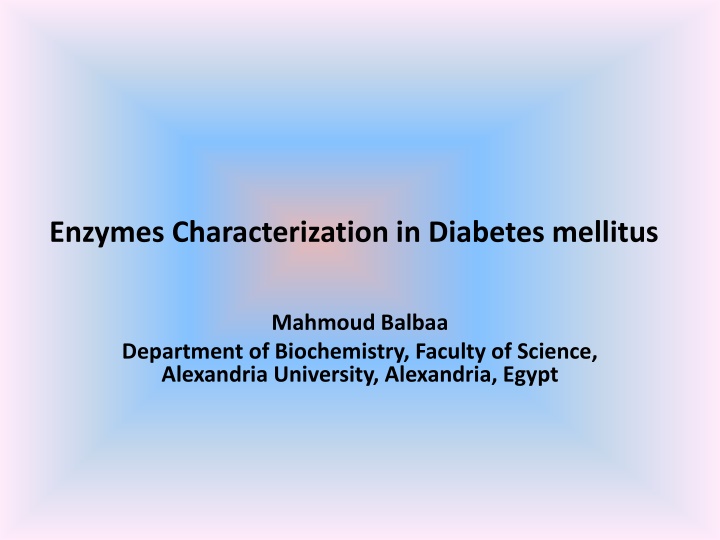
Enzymes in Diabetes Mellitus Research
Explore the role of enzymes in diabetes mellitus, focusing on lysosomal enzymes such as arylsulfatases and glycosidases. Learn about the characterization of these enzymes in patients and healthy individuals, as well as the impact of diabetes on enzymatic antioxidant defenses. Experimental studies using streptozotocin in disease models are also discussed.
Download Presentation

Please find below an Image/Link to download the presentation.
The content on the website is provided AS IS for your information and personal use only. It may not be sold, licensed, or shared on other websites without obtaining consent from the author. If you encounter any issues during the download, it is possible that the publisher has removed the file from their server.
You are allowed to download the files provided on this website for personal or commercial use, subject to the condition that they are used lawfully. All files are the property of their respective owners.
The content on the website is provided AS IS for your information and personal use only. It may not be sold, licensed, or shared on other websites without obtaining consent from the author.
E N D
Presentation Transcript
Enzymes Characterization in Diabetes mellitus Mahmoud Balbaa Department of Biochemistry, Faculty of Science, Alexandria University, Alexandria, Egypt
The enzyme in patients and healthy individuals or an animal model of disease is studied in a whole investigation of biomarkers of the disease. characterization of the
Diabetes Mellitus Diabetes mellitus (DM) is a chronic metabolic disorder complete or partial deficiencies in insulin production and/or insulin action coupled with chronic hyperglycemia and disruption in carbohydrate, metabolism. In addition, an alterations in enzymatic antioxidant defenses in DM was detected. The reactive oxygen species (ROS) overproduction induces lysosomal membrane permeabilization. characterized by lipid and protein
Experimental Diabetes Streptozotocin antibiotic with antineoplastic and diabetogenic properties that has been isolated bacterium of Streptomyces. (STZ) is an from a the genus
The research interest is focusing on the investigation variation and pathways in some diseases such as Diabetes mellitus. The target enzyme of our study are the lysosomal enzymes such as arylsulfatses and some glycosidases. of enzymatic signaling some
Lysosomal enzymes Lysosomal enzymes located in the lysosome and responsible for the degradation of biomolecules in the cell. They include many types which carbohydrates, lipids, proteins, nucleic acids and glycoconjugates. enzymes are digestive hydrolyze
Arylsufatases Arylsulfatase A (ASA): is a lysosomal enzyme known as cerebroside-3-sulfohydrolase. It desulfates the galactose-3-sulfate residues in cerebroside sulfate and other sulfated galactolipids. Arylsulfatase B (ASB): is a lysosomal hydrolase that desulfates the non acetylgalactosamine-4-sulfate glycosaminoglycans (GAGS). reducing residue terminal present N- in
Glycosidases Glycosidases are glycoprotein enzymes that hydrolyze glycosidic bond during the digestion process of carbohydrates. There are two classes of glycosidases. The first class includes exoglycosidases which are -glucosidase, - glucosidase and -glucuronidase. The second class includes endoglycosidases such as - amylase.
-glucosidase (EC.3.2.1.20) is an exoglycosidase enzyme that plays role in the breakdown of glycogen in the liver and muscles into glucose. This enzyme maltase/glycoamylase succrase/isomaltase Amylases (E.C. endoglyconases that catalyze the hydrolysis of -(1 4) glycosidic linkage in starch polysaccharides. posses both and - are activity. 3.2.1.1) and related
On the other hand, -glucuroniadse (EC 3.2.1.31), which is another vital exoglycosidase enzyme, plays role in the cleavage of -glucuronide linkage at the non reducing termini of glycosaminglycans chondroitin sulfate and hyaluronic acid. such as
OMICS International www.omicsonline.org OMICS International (and its subsidiaries), is an Open Access publisher and international conference Organizer, which owns and operates peer-reviewed Clinical, Medical, Life Sciences, and Engineering & Technology journals and hosts scholarly conferences per year in the fields of clinical, medical, pharmaceutical, life sciences, business, engineering, and technology. Our journals have more than 3 million readers and our conferences bring together internationally renowned speakers and scientists to create exciting and memorable events, filled with lively interactive sessions and world-class exhibitions and poster presentations. Join us! OMICS International is always open to constructive feedback. We pride ourselves on our commitment to serving the Open Access community and are always hard at work to become better at what we do. We invite your concerns, questions, even complaints. Contact us at contact.omics@omicsonline.org. We will get back to you in 24-48 hours. You may also call 1- 800-216-6499 (USA Toll Free) or at +1-650-268-9744 and we will return your call in the same timeframe. Contact us at: contact.omics@omicsonline.org
Biochemistry & Physiology: Open Access Related Journals Biochemistry & Pharmacology: Open Access Biochemistry & Analytical Biochemistry Journal of Plant Biochemistry & Physiology
OMICS Group Open Access Membership Open Access Membership OMICS publishing Group Open Access Membership enables academic and research institutions, funders and corporations to actively encourage open access in scholarly communication and the dissemination of research published by their authors. For more details and benefits, click on the link below: http://omicsonline.org/membership.php


